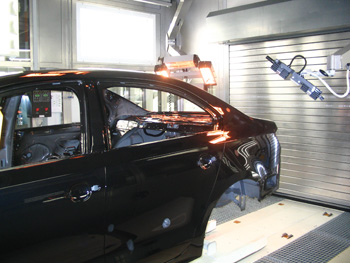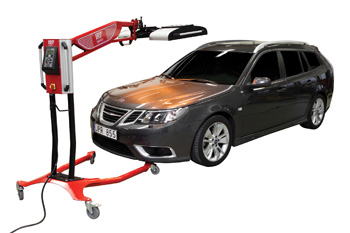
 With the emphasis on speed and cycle time today, collision repairers have turned to curing technology as one answer to help them be as efficient as possible in getting work in and out the door.
With the emphasis on speed and cycle time today, collision repairers have turned to curing technology as one answer to help them be as efficient as possible in getting work in and out the door.
An IR Renaissance
Word is there has been a recent surge in popularity in infrared (IR) heaters after a period of dormancy due to a glut of product in the market.
“There was a time when we were mostly just selling consumables and parts – because the market was so saturated in shortwave IR,” says Ed Weihs, vice president of sales and marketing for AMH Canada Ltd. “Everyone had a short-wave infrared lamp. But people now seem to be stepping up in quality.”
According to Weihs, the surge has taken place over the last 18 months, and shops’ main interest has been two things: overhead track systems and sidewall-mounted track systems that are off the floor, and installing these systems in prep stations.
“Most of the hits are two-panel hits where you’re not painting the whole car, so to turn on a whole booth and bake for one or two panels becomes a bottleneck in the shop,” Weihs explains. “So if you roll the car out to a prep area and cure it with shortwave IR, you free up a booth, which helps in throughput and productivity.”
Weihs says that multi-shop operations have been particularly committed to the “off the floor” concept for the obvious reason of creating better flow in the shop.
“It makes it easier to move vehicles through the shop and allows you to create a better shop design,” he says. “You don’t want to impede movement.”
The move to quality, Weihs says, has been driven by a variety of factors that are common to many industries when you’re putting low quality versus high quality equipment side by side.
“Maybe with the low quality items they’re not getting the same performance, coverage area, uniformity of cure and quality of cure they’re looking for. They might find they’re replacing the less expensive lamps too often. If you look at the way stands are made, they’re not very substantial. It doesn’t matter so much in the little ones like the 1,200-watt, but if you’re getting into a 4,000- or 8,000-watt shortwave lamp, it has to be substantial.”
There are the traditional uses of IR (curing filler and waterborne coatings, which repairers are using a combination of IR and heated air to do), but Weihs has also seen people using it for everything from heating material so it can be formed (motor coach and tour bus aluminum skins) to softening clay for modeling vehicles.
Drying Waterborne
Based on his own sales figures, Mike Bertrand of Hedson Technologies N.A. confirms a large upsurge in demand for IR heaters.
“Waterborne does work with IR, so people are finding that out, especially if they’re working with that type of material in a humid environment,” he says. “Plus, all the old arguments for IR are still valid – it’s a very cost effective way to go, it offers line-of-sight curing for a fast, effective cure for two panels on down, and it can reduce cycle times.”
Bertrand says consolidation also has helped in that more and more organizations are running more professional businesses and looking for best practices to improve efficiency.
Bertrand admits the product itself hasn’t changed much except for the control side, where, by adding sensors and new reflector materials and shapes, Hedson has been able to make the IR curing process simple.
“It’s now a one-button operation with a fast, consistent result every single time. All of these things are driving markets for more and more of these machines,” he says.
Not only has there been greater interest for lower ticket items at the $5,000 price point, Bertrand says, but also the higher end paint curing arch that can cost between $60,000 and $70,000, although he says “no deals have been closed yet.”
“It gets installed in the spraybooth and is fully computerized where the painter can highlight the panels they want to cure on the screen. The arch will come out and light up those different panels and then travel back to the parking area.”
Bertrand can’t emphasize enough the effect waterborne coatings has had on the demand for IR units and that, in his opinion, air movement alone is not the solution.
“We sell a ton of IR in Europe because they’re way ahead of us on waterborne, and for awhile there it was thought what you needed to dry water was just air. Venturis and whatnot help enhance drying, but IR is effective on water as well. IR can be used as a standalone, but most of the time if a car is in the prep area or booth, they’ll just leave the air going to enhance the overall process.”
Heat Plus Air
Joe Petro with Infratech describes the drying process from a more technical angle. He explains that with waterborne, the water is sitting on the surface and needs to be absorbed by the air and carried away. Air flow works because, if you’re pushing fresh air over it, the air you’re blowing is unsaturated and thus can absorb more and carry it away. But the story is different on high humidity days.
“Even air flow has a hard time driving water out on those days because the air is saturated and can’t hold any more water, so how do you trick it and make the air capable of picking up more water and carrying it away?” says Petro. “You either circulate a lot of air if you’re only at 97 to 98 percent humidity, or you use heat to force more solvent or water into the air. That’s what IR is really effective at.”
Plus, Petro says IR lets you heat only specific spots and you don’t have to heat the whole booth. And you can roll the mobile ones around in the shop, using them in other work areas and prep bays.
Petro agrees with Bertrand that there have been no whiz-bang technological advancements in IR over the last 15 to 20 years, other than in controls.
“I like to think [Infratech] is innovative in regulating heat based on temperature versus distance,” he says. “We recognize distance isn’t always a luxury body shops have. Sometimes you only have 18 to 24 inches to position a heater. We offer controls with our digital temperature sensor where you type in ‘150 degrees’ and it scans the surface and regulates the heat output no matter what distance you are from the panel.”
Interest at the SEMA Show bolstered Petro’s belief that IR is making a comeback, but he was discouraged to hear people bring up an old misconception.
“When IR first came out, people loved it because we didn’t deposit dust in the finish, whereas venturis and air nozzles did,” Petro says. “But at SEMA, I had five people ask how much dust I was going to put in the finish, which was surprising because people stopped asking that question years ago and now they’re starting to ask it again. But that’s an airflow issue – and why people use spraybooths and good filtration to keep them clean.”
Petro is encouraged to see that repairers are once again seeing the value in IR and interested
in seeing how it can help their productivity.
“People are going back to technology they understand and are comfortable with and are buying an extra one to two IR lamps, even small entry-level ones, to help move in that direction.”













